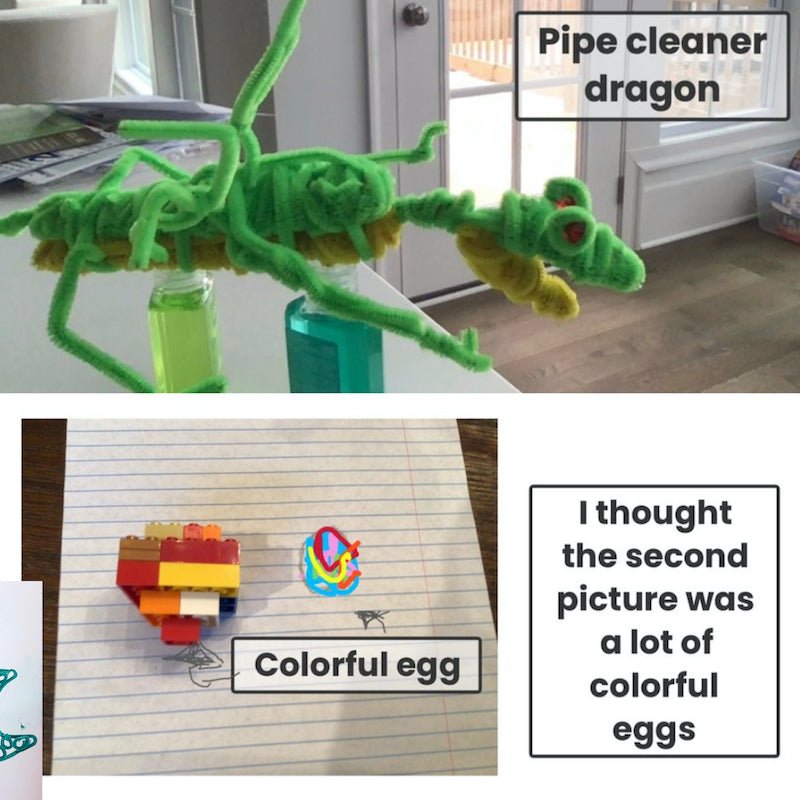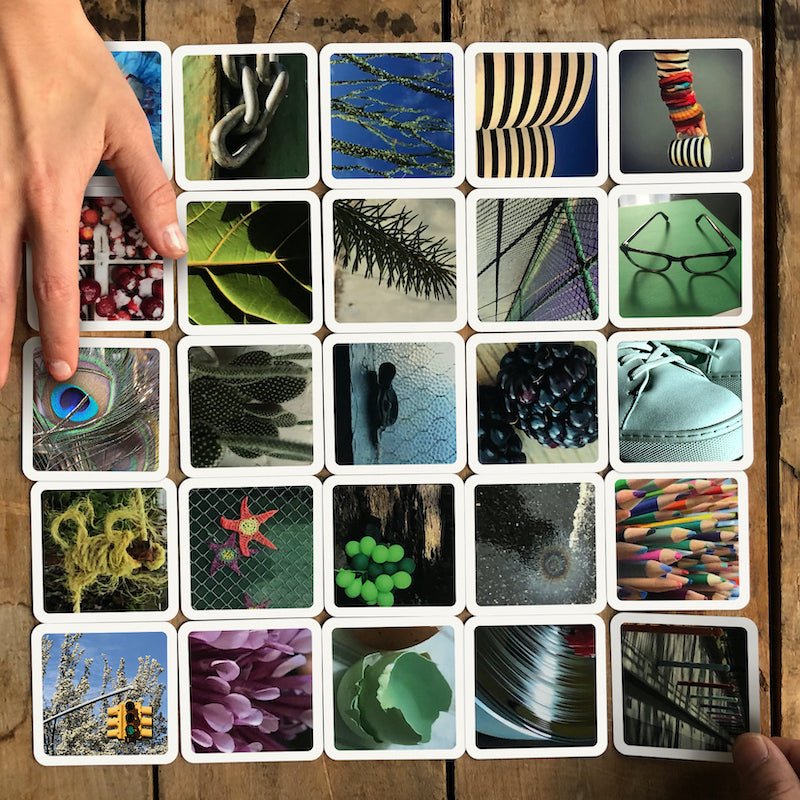The activities below use OuiSi, a set of “visually-connecting” photo cards which you can find here. Teachers can email info@ouisi.co for an educator discount (just tell them a bit about yourself and your classroom!). If OuiSi isn’t right for you, the activities referenced in this post can be adapted to the tools and activities at your disposal.

Any day you happen into a classroom at my school, you will find a Morning-Meeting message board to greet eager learners. Morning Meetings are part of the Responsive Classroom approach, which is a student-centered, social-emotional learning method. Morning messages anchor and prepare students for the direction of the day's learning. Morning Meetings also include a greeting to acknowledge fellow peers with respect, a sharing period to build community, and an activity period to stimulate thinking and movement.
Curious what this looks like in practice? Here's a recent day in the life of a fourth-grade class.
The Morning Message and Greeting
Good Morning Scientists! We have been learning so much about how powerful the brain is. Did you know that when we see colors, our brains create chemicals that make us feel different emotions? We will learn more about this in science today. For now, look at these four OuiSi cards each representing a different color. Which OuiSi card are you feeling like today? Place a tally mark next to the card you most feel like today. Love, Ms. Brown
The children go about their morning routines of unpacking, settling in, and beginning some morning work as they ease into their school day. When a chime sounds, the children carefully listen to the instructions and begin cleaning up and making their way to the meeting area. Typically, this is a large enough area where the students and teachers can assemble in a circle so that everyone can be seen and heard.
To begin the meeting, they greet each other by using eye contact, and kind words to acknowledge each person in the class. After everyone feels seen and heard, they transition into the sharing portion of the meeting.

The Sharing Period
The teacher places a basket into her lap filled with photo cards. She leans over to the student on her left and asks her to draw one. The child reaches into the basket and digs her small fingers under and through the pile of cards, until she retrieves the chosen one and proudly holds it high in the air for all to see. The teacher places it under her document camera so the children learning from home can see the card while the students present can see the card projected onto the whiteboard.
The teacher then asks the child who selected the card to share with the class something they “observe, wonder, or know about the image on the chosen card.” Each student will do the same and they go around the circle clockwise. The sharing begins:
- “I see poles sticking in the ground.”
- “I see that the poles are on the sidewalk.”
- “These poles are rainbow colors!”
- “I wonder why they are all different colors?”
- “Who painted them?”
- “What do these poles do?”

These observations continue until everyone in the circle (and learning from home) has shared. The teacher invites the students to reflect, saying “I heard many questions and inferences in our sharing. Now, what story can we tell about this image?” The students shoot their arms up, desperate to release the creative energy bubbling from within. They have been ruminating on those poles in the sidewalk since they began examining the photo card. Organically, this transitions into the activity portion of the meeting.
The Activity Period
Turning to the student on her right and moving counterclockwise around the circle this time, the teacher prompts the student, “Begin the story for us with one sentence. Once you’ve contributed to the story, pass the card to the next person.” The student nods and clears their throat:
- “It was a hot day.”
- “But the work had to be done,” continues the next student.
- “The orders came from City Hall,” adds the third.
- “Cyclists had no where to park their bikes.”
- “When they played at the playground in the park.”
- “It was too dangerous for them to leave them on the road.”
As the students continue to build out their imaginative story, the teacher records it in a notebook. The laptop featuring the remote learners holds a space in the circle, and the card is held up the webcam so they may contribute to the story. Once everyone has contributed, the teacher reads it aloud to the class. They laugh and cheer at its conclusion.
The teacher scribbles the date into the corner of the story and hands it to a student who collects a binder from the library shelf. They snap the story into the front of the binder where it stands proudly on top of other collaborative writing pieces the class has written.

The teacher redirects the class’ attention back to their Morning Message. From earlier there are tally marks next to each OuiSi card taped to the message board. The virtual students have left their tally marks in the video chat window. The teacher reflects on each of the cards. “Oh, it appears that twelve of our friends are feeling like these purple flowers. Three of you are feeling more like a tan poppy seed bagel. Seven of you are feeling like this red umbrella. Two of you are feeling like this yellow rope. Please turn to a neighbor and tell them which OuiSi card you have chosen, and why.”
The chattering begins. Students learning virtually have previously established partners for this type of thing. As the excitement of the conversation begins to settle, the teacher regains their attention with the chime.
Transitioning to the Day
She softly says, “As we move into our individual writing this morning, I want you to take the first five minutes to reflect in your science journal about how you think colors are connected to our feelings. Use the reasoning you and your neighbor shared to help you. You may begin as soon as you get to your seat.”
Just like that, as if a spell had been cast over the class, they immediately retrieve their science journals and begin penning their observations, wonderings, and what they know about the connection between colors and feelings.
Connection
Morning meetings generally have a message, greeting, sharing and an activity, but there are many ways to express the format. For inspiration for your classroom, head here. To learn more about the Morning Meeting format and the Responsive Classroom approach, go to responsiveclassroom.org. We'd love to know what you are doing in your classroom, so let us know in the comments below, or tag us on social media at @playouisi.
Stay Connected,
Jocelyn Paez



2 comments
Gwen
I am going to incorporate these cards into my therapy! We often work on mindfulness – choosing where to focus for grounding or connection with our holistic selves, we work on building skills in empathy, we work to connect together in groups for a sense of belonging, and use senses to be grounded and present. Looking for moments of “awe” in the present helps many with a spiritual connection to the world and their higher power.
I am going to incorporate these cards into my therapy! We often work on mindfulness – choosing where to focus for grounding or connection with our holistic selves, we work on building skills in empathy, we work to connect together in groups for a sense of belonging, and use senses to be grounded and present. Looking for moments of “awe” in the present helps many with a spiritual connection to the world and their higher power.
Cindy
I love the responsive classroom book. I started every single morning of my teaching career using morning meeting. I LOVE The ideas you share in this article! I am encouraging people to purchase the cards to play with families now I will share this article with teacher friends.
I love the responsive classroom book. I started every single morning of my teaching career using morning meeting. I LOVE The ideas you share in this article! I am encouraging people to purchase the cards to play with families now I will share this article with teacher friends.